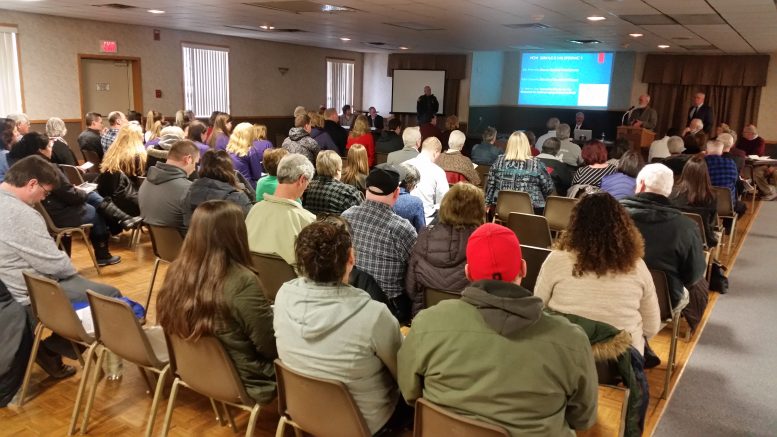By JAN LARSON McLAUGHLIN
BG Independent News
The chief toxicologist with Lucas County Coroner’s Office studies death for a living. He has never seen anything like the opiate epidemic.
“There has never, ever, ever, ever been anything in our country like this,” Dr. Robert Forney said Sunday during an opioid forum sponsored by the Eastwood Community Improvement Corporation and led by Dr. Ted Bowlus, a Wood County commissioner and physician.
“We are killing more people every year than we lost in the Vietnam War,” Forney said at the meeting held in Pemberville. The death statistics are similar to a 737 crashing each day. “The numbers are just unbelievable.”
Forney’s toxicology work covers 21 counties, including Wood. In 2010, his office saw eight opioid deaths. By 2017, that number had jumped to 350.
“There are going to be more in 2018,” he predicted.
Others on the panel are working to prevent those numbers from growing in Wood County.
Most recently, Wood County Prosecuting Attorney Paul Dobson set up the Addiction Response Collaborative.
“There is an industry out there that hates what we’re doing here today,” Dobson said of the illegal drug trade. “We’re at war with that industry.”
Dobson, who lost a stepson to opiate overdose, said his office takes that war seriously. “We’re one of the most aggressive offices prosecuting drug dealers who kill their buyers.”
But that isn’t enough, he added. “In a war, we take in the refugees.”
That’s where ARC comes in. Belinda Brooks and Deputy Ryan Richards work with ARC to keep track of opiate addicts and give them every opportunity to get clean.
For Richards, that means random checks. “I want to make sure he knows I’m watching him.”
For Brooks, that means getting the addicts set up with Medicaid and other services.
“We stay with them for the long haul. It’s so easy for them to relapse,” said Brooks, whose daughter was an opiate addict.
Since ARC started in November, the program has worked with 15 addicts – 14 who are still sober, she said.
More than 80 percent of opioid addicts get started by misusing prescription drugs, according to Kyle Clark, prevention education director with the Wood County Educational Service Center.
“This epidemic is quietly creeping in several homes,” Brooks said.
Many Wood County residents have lost loved ones, or know of someone who has, Wood County Chief Deputy Eric Reynolds said.
“You’re all here today to be that spoke in the bicycle wheel,” he said. “All of you are here to do more.”
Reynolds presented some stats on opioid deaths. In 2016, the nation saw 64,070 opioid overdose deaths, Ohio saw 4,050, and Wood County saw 21. The Wood County Sheriff’s Office administered six doses of Narcan to bring back overdose victims, while EMS departments used it 102 times. Recently, an off-duty deputy administered Narcan when an overdose victim ran his car into the deputy’s home, Reynolds said.
A growing number of parents are losing their jobs and custody of their children due to their addictions, said Tom Clemons, executive director of the Wood County Alcohol, Drug Addiction and Mental Health Services Board.
“There’s a real crucial needs for foster parents,” to care for those children left behind, Clemons said.
Dobson compared opioid deaths to road accident fatalities. Those killed on Ohio roads totaled 990 in 2013; 1,009 in 2014; and 1,100 in 2015. In the same period those killed with accidental overdoses in Ohio were 2,000 in 2013; 2,400 in 2014; and 3,050 in 2015.
“But there’s a danger in only looking at mortality rates,” Dobson said. “The problem’s larger than people dying.” The problem is also the toll that living with opioids takes on addicts and on their families, he said.
“These numbers are horrific. They are friends and family,” Dobson said. “It’s not in the back alleys – it’s in your homes.”
Clark agreed. “We have to stop thinking of this as a behavioral problem. It’s not the guy down under the bridge from the ‘60s,” he said. “It’s a brain disease. The sooner we can accept that, the sooner we can make changes.”
The stigma surrounding opioid addictions is compounding the problem.
“There is a stigma that goes along with drug addiction,” Dobson said. “There are people in families who aren’t getting help because of the stigma.”
Bowlus explained the effects of opiate addictions on the brain. “If you don’t satisfy the cravings, the withdrawal symptoms increase,” he said.
Symptoms of opioid addiction include apathy, disorientation, euphoria followed by drowsiness, weight loss, slow heart rate, and pinpoint pupils. Withdrawal symptoms include substantial cravings, restlessness, headaches, insomnia, anxiety and dilated pupils.
Bowlus echoed the concern about misuse of prescription pain pills. After having back surgery 10 weeks ago, he was given a prescription for 40 pain pills. “If I would have taken 40, I would have been addicted.” Bowlus also recalled a patient who was prescribed 90 Percocet after having her wisdom teeth pulled. “They are still over-prescribing,” he said.
Clemons talked about the value of prevention programming and of treatment programs.
“I just want to let you know, treatment does work.” However, relapses are frequent, and it can take up to seven years for the brain to fully recover, Clemons said. The Centers for Disease Control has called opioids the “most addictive” substance, he added.
So what else is Wood County doing about the opioid crisis?
- 18 programs are in the schools to teach students how to avoid drugs. In many schools there are youth leading other students to avoid opiates.
- There are detox services, then programs to help people find safe apartments, jobs and transportation back and forth. “We’re trying to reduce barriers to treatment,” Clemons said. “Cost should never be a reason to keep people from getting treatment.”
- A nine-bed house for males trying to break their addictions is located in Cygnet. The county is looking for a location for a house for females, said Aimee Coe, director of Community Programs with ADAMHS.
- Vivitrol is given to inmates prior to their release from the jail, which takes away the pleasant feelings they get from opioids, and makes it easier for addicts to kick their habits.
- Support groups have been set up for families of addicts.
Forney talked about the increasing potency of opioids, and the increasing costs for treatment, foster care, police overtime, EMS and hospital emergency rooms.
He also talked about those most likely to get addicted. “It’s mostly white men,” with the average age of overdose at 38, he said.
Forney’s theory is that problems began with this generation when they became “latch-key” children once both parents worked outside the home, and the traditional family unit began to fall apart. The problem worsened as children began to spend so much time in front of “screens.”
“Unless we change the way young people are growing up, I predict it will continue,” he said. Forney suggested parents “make your backyard more interesting than television,” that they set examples by doing volunteer work, that they read more to their children, and they follow teachings of the Bible.
So what can the public do to help?
- Talk about it, advised Brooks. “By not talking about it, this festers,” she said. “As a parent, you can’t fix this. Don’t be ashamed, it’s happening everywhere.”
- Be watchful for missing money, missing spoons or missing medications, Richards said. Be aware that abnormal throwing up and sneezing can be signs of opiate use. And be watchful of unusual repeated vehicle traffic on your street.
- Be prepared to offer help – immediately. “When somebody asks for help, they mean right now,” Coe said.
- Treat people addicted to opioids as having an illness. “What would you do if your neighbor had Stage 3 or Stage 4 cancer,” Clark asked. You would talk with them, you would offer to take them to treatment, he said.
- Become a foster parent.
- Don’t leave prescriptions out where they can be taken. “People are getting a hold of our medications. Lock them up,” Clark said.
- Dispose of old medications at the county’s 24/7 drop-off sites. Last year, 248 pounds of medications were disposed of at the drop-off boxes, Reynolds said.
- Parents need to talk with their kids, since kids whose parents talk with them about drugs are 50 percent less likely to start doing drugs, said Milan Karna, Wood County Prevention Coalition coordinator.
- Get Narcan to revive an overdose victim. The Narcan is free with a 30-minute training, Coe said.
- Call 211 for information on how to get help.





